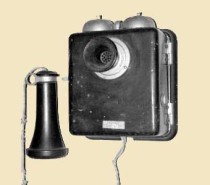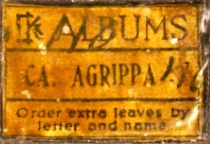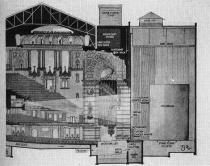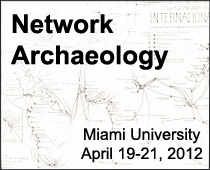
Network Effects?
Presentation by Richard R. John (Columbia University). Today it is a truism to contend that networks become more useful as they expand. We even have a phrase for it: “network effects.” The early history of the telegraph and telephone network

Network Effects?
Presentation by Richard R. John (Columbia University). Today it is a truism to contend that networks become more useful as they expand. We even have a phrase for it: “network effects.” The early history of the telegraph and telephone network
The Information Defense Industry and the History of Networks
Presentation by Adrian Johns (University of Chicago). With the rise of the information economy has come the development of an industry devoted to policing that economy. It is a hybrid enterprise, composed of both public institutions like the FBI and
The Information Defense Industry and the History of Networks
Presentation by Adrian Johns (University of Chicago). With the rise of the information economy has come the development of an industry devoted to policing that economy. It is a hybrid enterprise, composed of both public institutions like the FBI and

Remembering Networks: Agrippa, RoSE, and Network Archaeology
Presentation by Alan Liu (UC Santa Barbara). In 1992, at the onset of today’s digital networks, publisher Kevin Begos, Jr., artist Dennis Ashbaugh, and science-fiction novelist William Gibson issued their collaborative artist book Agrippa (a book of the dead), whose

Remembering Networks: Agrippa, RoSE, and Network Archaeology
Presentation by Alan Liu (UC Santa Barbara). In 1992, at the onset of today’s digital networks, publisher Kevin Begos, Jr., artist Dennis Ashbaugh, and science-fiction novelist William Gibson issued their collaborative artist book Agrippa (a book of the dead), whose

A Public Philosophy for Data Capture Systems
Presentation by Jussi Parikka (University of Southampton). This talk investigates topologies of publicness in relation to real time networking. By engaging with H. Sackman’s “A Public Philosophy for Real Time Information Systems” (1968) and other 1960s and 1970s sources, I

A Public Philosophy for Data Capture Systems
Presentation by Jussi Parikka (University of Southampton). This talk investigates topologies of publicness in relation to real time networking. By engaging with H. Sackman’s “A Public Philosophy for Real Time Information Systems” (1968) and other 1960s and 1970s sources, I

Transfer of Frameworks from Old Network Technologies to New Ones
Presentation by Harmeet Sawhney (Department of Telecommunications, Indiana University, Bloomington), Venkata Ratnadeep Suri (Department of Telecommunications, Indiana University, Bloomington), and Hyangsun Lee (Research Fellow, Office of Planning and Management, Korea Communications Standards Commission, Seoul, Korea). The Interstate Commerce Act developed for regulating the

Transfer of Frameworks from Old Network Technologies to New Ones
Presentation by Harmeet Sawhney (Department of Telecommunications, Indiana University, Bloomington), Venkata Ratnadeep Suri (Department of Telecommunications, Indiana University, Bloomington), and Hyangsun Lee (Research Fellow, Office of Planning and Management, Korea Communications Standards Commission, Seoul, Korea). The Interstate Commerce Act developed for regulating the
Terms of Reference: Situating Certain Literary Transactions over Networked Services
Presentation by John Cayley (Brown University). Since the 1990s, to read and write with a computer has implied that we read and write with a network. We have been placed—you and I have placed ourselves—in the position of ‘using’ hardware and
Terms of Reference: Situating Certain Literary Transactions over Networked Services
Presentation by John Cayley (Brown University). Since the 1990s, to read and write with a computer has implied that we read and write with a network. We have been placed—you and I have placed ourselves—in the position of ‘using’ hardware and

Becoming Network. Henry C. Beck, Material Culture and the London Tube Map of 1933
Presentation by Sebastian Gießmann (Internet Policy Advisor to the Greens in the German Bundestag). What makes a material network a navigable social space? In my contribution, I will try to demonstrate that the relation of built structures and their media

Becoming Network. Henry C. Beck, Material Culture and the London Tube Map of 1933
Presentation by Sebastian Gießmann (Internet Policy Advisor to the Greens in the German Bundestag). What makes a material network a navigable social space? In my contribution, I will try to demonstrate that the relation of built structures and their media

Digging Through Archives and Dirt: Entangling Media Archaeology, Archaeology Proper, and Architectural History
Presentation by Shannon Mattern (The New School). In the introduction to their new media archaeology anthology, Erkki Huhtamo and Jussi Parikka propose that “[m]edia archaeology should not be confused with archaeology as a discipline. When media archaeologists claim that they

Digging Through Archives and Dirt: Entangling Media Archaeology, Archaeology Proper, and Architectural History
Presentation by Shannon Mattern (The New School). In the introduction to their new media archaeology anthology, Erkki Huhtamo and Jussi Parikka propose that “[m]edia archaeology should not be confused with archaeology as a discipline. When media archaeologists claim that they

Half-Inch Revolution: Guerrilla Television’s Tape Networks
Presentation by Kris Paulsen (The Ohio State University). The Rays, a 1970 videotape by the Raindance Corporation, shows something curious: As the three collaborators record each other, rhythmic waves flow across the screen. In each wave there are bits of

Half-Inch Revolution: Guerrilla Television’s Tape Networks
Presentation by Kris Paulsen (The Ohio State University). The Rays, a 1970 videotape by the Raindance Corporation, shows something curious: As the three collaborators record each other, rhythmic waves flow across the screen. In each wave there are bits of
Dolphins, Drugs and Circuitry: Network-building in Postwar Interspecies Communication Research
Presentation by John Shiga (McGill University). In the 1950s and 1960s, renowned neurophysiologist, John C. Lilly, received funding from several U.S. government agencies including NASA and the U.S. Navy to conduct experimental research on the feasibility of human communication with dolphins.
Dolphins, Drugs and Circuitry: Network-building in Postwar Interspecies Communication Research
Presentation by John Shiga (McGill University). In the 1950s and 1960s, renowned neurophysiologist, John C. Lilly, received funding from several U.S. government agencies including NASA and the U.S. Navy to conduct experimental research on the feasibility of human communication with dolphins.


